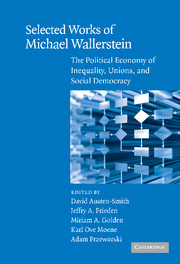 Selected Works of Michael Wallerstein
Selected Works of Michael Wallerstein Published online by Cambridge University Press: 27 January 2010
Although a great deal of Michael Wallerstein's work concerns the inequality of income, wages, and wealth, very few of his papers contain significant normative claims beyond those of economic efficiency. Of course, the fact that Wallerstein eschewed any substantive normative discussions in his work does not imply that he held no views on the fairness or otherwise of particular patterns of wage and income inequality; far from it. Rather it reflects his belief that, before any compelling normative case can be made regarding any given distributions of income or wealth, it is necessary to understand as deeply as possible exactly how such distributions come about. And while there are a great many reasons offered in the literature for levels and changes in income inequality, Wallerstein focused on exploring how political-economic institutions influence and support particular distributions of income.
In the early 1980s, the ratio of wages earned by those in the 50th percentile of the wage distribution to those in the 10th percentile was 1.96 in the US, 1.64 in France, and 1.31 in Sweden. By the late 1990s, the ratios were 2.1, 1.59, and 1.39, respectively. Over the same period, evidence from a set of eighteen OECD countries (including the US, France, and Sweden) indicates, first, a strong negative correlation between pretax income inequality and government spending on “safety net” insurance against loss of income and, second, a negligible relationship between pretax income inequality and any purely redistributive government spending in favor of the poor.
To save this book to your Kindle, first ensure [email protected] is added to your Approved Personal Document E-mail List under your Personal Document Settings on the Manage Your Content and Devices page of your Amazon account. Then enter the ‘name’ part of your Kindle email address below. Find out more about saving to your Kindle.
Note you can select to save to either the @free.kindle.com or @kindle.com variations. ‘@free.kindle.com’ emails are free but can only be saved to your device when it is connected to wi-fi. ‘@kindle.com’ emails can be delivered even when you are not connected to wi-fi, but note that service fees apply.
Find out more about the Kindle Personal Document Service.
To save content items to your account, please confirm that you agree to abide by our usage policies. If this is the first time you use this feature, you will be asked to authorise Cambridge Core to connect with your account. Find out more about saving content to Dropbox.
To save content items to your account, please confirm that you agree to abide by our usage policies. If this is the first time you use this feature, you will be asked to authorise Cambridge Core to connect with your account. Find out more about saving content to Google Drive.